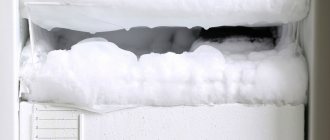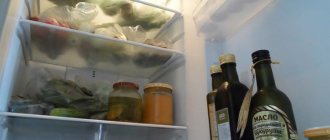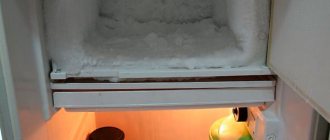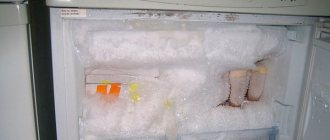What should you do first?
- In order to properly defrost an old model refrigerator, naturally, you should first empty it of food. Even if food supplies are packaged tightly enough, it is better to remove them while defrosting.
- Before you start defrosting, you should turn off the refrigerator. First, this needs to be done because it is likely that the thermostat will respond to a sudden increase in temperature by increasing its cooling capacity. And secondly, if the ice begins to melt, it may happen that the water and electronics come into contact with each other. The result is water damage or even electrical shock.
- In preparation for defrosting, remove everything that can be easily removed, including drawers, shelves, and the egg tray. If the shelves are frozen, to avoid breaking the plastic parts, do not use force to remove them. Simply wet the joints with warm water and dish soap and leave for a while.
How long
The natural thawing process can take a full day. How many hours this process will take depends on the thickness of the ice.
Defrosting the refrigerator
It is recommended to defrost any model traditionally - leaving it overnight. If desired, you can speed up the process manually. To do this, many housewives use: hair dryer, hot water and steam.
Important! Attempts to properly remove ice may cause damage to the device.
Manufacturers recommend turning on the refrigerator after 10-13 hours of defrosting. During this time, the pressure in the refrigerant circulation system and on the compressor piston will have time to decrease.
If you connect the device to the power supply earlier than the specified time, the engine will take longer to start the rotating crankshaft, which may cause damage.
Express defrosting methods
- For most brands, simply leaving the refrigerator door open is sufficient. But the process is quite long. To speed up the defrosting time, you can use a hairdryer. But to avoid melting the plastic or rubber seal, keep it at least 20 cm from the surface. In addition, this way you will be protected from contact with melt water.
- A covered pan of hot water, which is best placed at the bottom of the refrigerator, will help you quickly get rid of the ice crust. But in this case, it is recommended to close the door so that the heat remains only inside. Depending on the degree of icing, defrosting in this way will take from half an hour to 2-3 hours.
- Alternatively, blow warm air inside the refrigerator using a floor or table fan.
Defrosting instructions for modern refrigerator models with the No Frost option
Modern silent models are almost completely autonomous. The owner needs to follow simple instructions:
- Set the thermostat to 0 degrees.
- Unplug the refrigerator.
- Remove food items and remove all shelves.
- Leave the doors open.
After a couple of hours there won’t be a single piece of ice left on the walls. All excess water will be collected in a special built-in container at the back of the refrigerator. And it won't need to be cleaned. The last step is to wash the inside of the refrigerator. You also need to wipe it dry.
Note! Modern two-chamber models allow you to defrost the freezer and refrigerator compartments separately. This is convenient, since food can be temporarily transferred to a closed compartment.
After hygienic treatment, you need to turn on the power and close the refrigerator door. After about half an hour, you can load the food back and set the thermostat to the desired temperature.
How to remove melted ice?
When the ice melts, you need to carefully pry it off and remove it. Use only a plastic or wooden spatula for this. Under no circumstances should you force events and remove the ice with a knife. At best, the knife will leave scratches, at worst – microcracks, which will then be difficult to restore. Therefore, it is better to be patient and wait until the ice begins to melt on its own.
Dish towels, old newspapers or soft rags are usually used to catch the water that forms during defrosting. Don’t forget to remove them from the inside from time to time and squeeze them thoroughly.
Why do you need to defrost?
The principle of operation of refrigeration equipment is the circulation of refrigerant through the pipes. Because of this, when warm air gets inside, moisture condenses on the walls and frost forms. The more often the door opens, the faster this happens. Over time, the layer of ice grows and begins to interfere with the normal operation of the device.
Any old refrigerator will develop a layer of ice quickly. If you don't get rid of it, the free space decreases and there will be nowhere to put food. Therefore, housewives used to defrost the refrigerator every month. In modern appliances, frost does not form as quickly. Many are equipped with an automatic defrost function, while others have protection mechanisms against ice formation. But they also need periodic defrosting.
Why ice may form:
| Cause | What's happening |
| Deformation of the seal or sagging door hinges | Warm air gets inside |
| Thermal sensor is broken | The compressor does not turn off |
| Refrigerant leak | The compressor runs non-stop |
| Hot food is placed on the shelves | Condensation forms |
| The cells are overcrowded | Air cannot circulate freely |
Defrosting the refrigerator is necessary not only to remove ice. This is a way to remove unpleasant odors and microorganisms that settle inside during operation of the device.
Ice in the freezer
Why is ice dangerous?
Not everyone understands why you need to defrost a refrigerator. Ice build-up reduces free space and food may freeze. But ice often causes serious problems:
- cooling efficiency decreases, the temperature inside rises;
- frequent activation of the compressor;
- frost melts, droplets of moisture can lead to corrosion;
- pieces of food frozen into ice cause an unpleasant odor and the growth of bacteria;
- frost can damage the sealing rubber and the door will no longer close tightly;
- the weight of ice can damage tubes, plastic walls, and other parts.
Should you disinfect your refrigerator?
Once the layer of ice has been removed, take the opportunity to clean your refrigerator properly. To do this, use warm water and dishwashing detergent.
If you prefer natural remedies, mix warm water with vinegar. In this way, you can not only get rid of the unpleasant odor that has formed in the refrigerator, but also disinfect the device at the same time. The latter also needs to be done from time to time, since, despite low temperatures, microorganisms continue to multiply. Read more about how to get rid of odors in your refrigerator here.
When can I turn the refrigerator back on? This can be done immediately after defrosting the freezer and cleaning it. The main thing is that the inside is completely dry by this time.
We answer popular questions
Before we begin to initiate you into the mystery of the refrigerator defrosting process, we will answer three questions that users most often ask.
No. 1. Where does frost come from in the refrigerator?
Warm air enters the refrigerator and freezer when we open the door to remove or put something in. Hence the appearance of ice. If you begin to notice that ice is building up very quickly, then you need to check the operation of the thermostat or the condition of the rubber on the door.
No. 2. Why do you need to defrost the refrigerator?
If the ice is not removed, it will interfere with the use of the refrigerator, cause the compressor to wear out and be less efficient, and the electricity bill will rise.
No. 3. How often should you defrost your refrigerator?
There is no strict rule regarding how many times to defrost your refrigerator. Be aware of the appearance of ice. For example, if the refrigerator is old, ice forms faster and more often, you need to clean it about once a month. If you have a No Frost refrigerator, etc., then once every six months will be enough.
Features of defrosting specific types of equipment
Previously, refrigerators worked on the same principle, and different models were almost the same. Therefore, problems with defrosting usually did not arise. The housewives didn’t even think about how many months later to do this. As soon as a layer of ice appeared, they got rid of it. But now many modifications have appeared that differ in their operating features and design. Each model requires a special approach to defrosting.
Refrigerators with drip defrosting system
Most models are equipped with a drip system. They turn on and off after a certain time. When the temperature drops, frost may form on the walls. After switching on, it melts and the drops flow through the drains into the drainage hole. The water is discharged through the tube into the pan.
Ice does not form in the refrigerator compartment of such appliances. But the freezer does not have this system. When the layer of frost reaches 5-7 mm, the device needs to be defrosted. This needs to be done 1-2 times a year.
Air evaporative refrigerators
In such models, moisture evaporates using a fan. Therefore, frost does not form. But they also need to be defrosted once a year for preventive cleaning and freeing the freezer from ice.
Dual chamber devices
Two-chamber models are popular, in which the freezer is located separately - on top or bottom. The defrosting process is no different unless the refrigerator has two compressors. In this case, you can defrost the refrigerator or freezer separately. This makes it convenient to store food by transferring it to another compartment.
Double chamber refrigerator
What not to do when defrosting
Sometimes, after defrosting, the refrigerator begins to malfunction, cools worse, or frost forms faster than before. Common mistakes can lead to such problems. What not to do when defrosting the refrigerator:
- chip off the ice with a knife or scrape it with sharp objects or hard brushes;
- peel off the ice crust using force;
- heat rubber seals;
- turn on the refrigerator after defrosting without drying it.
Important!
You can turn on the refrigerator after defrosting only after drying all the moisture!
It is also often not recommended to carry out this procedure on hot days. It is believed that at elevated air temperatures when turned on, the compressor may overheat, cooling the heated walls. You can avoid this by turning it on at night when it is cooler.
Do not scrape ice with sharp objects











